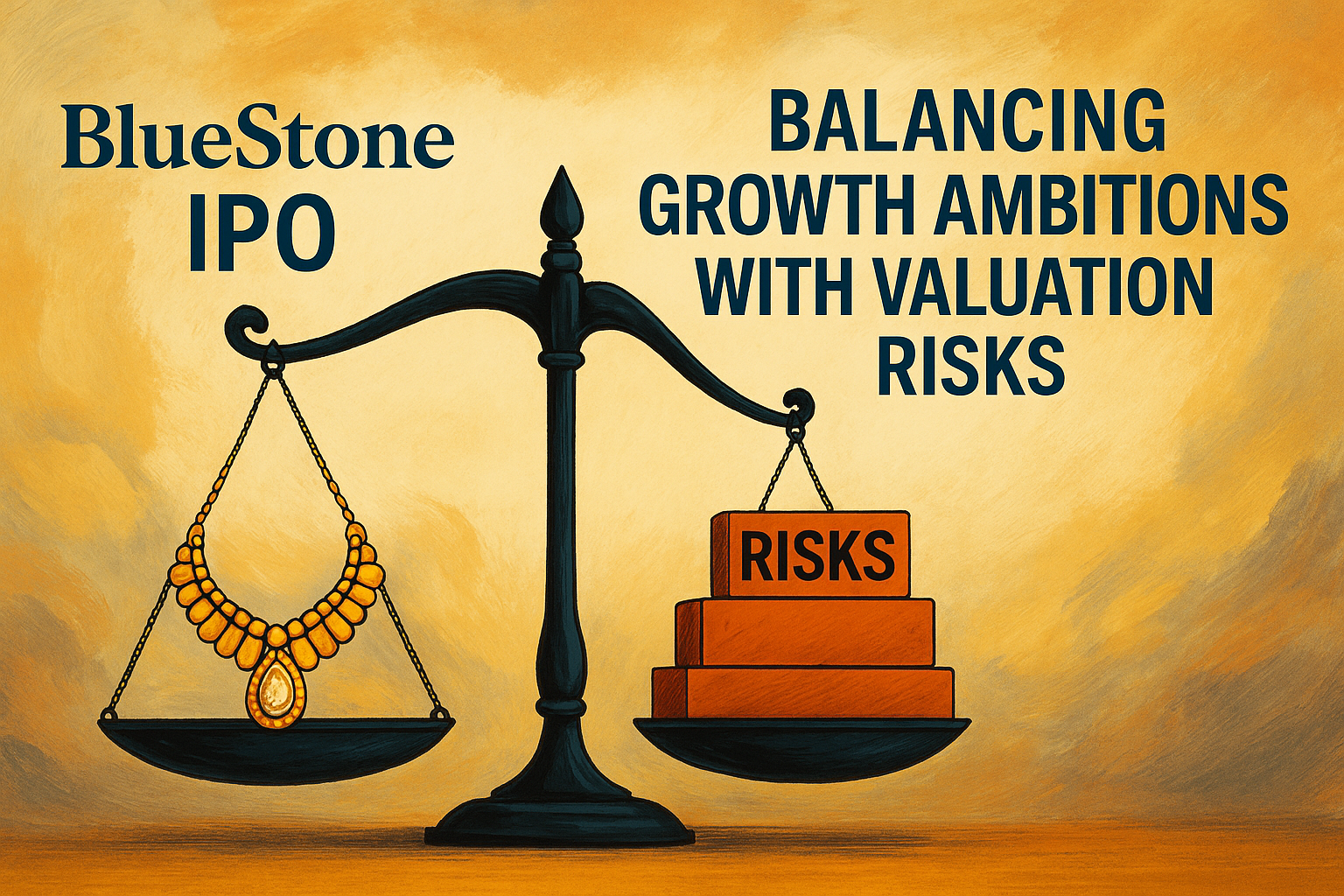BlueStone, India’s second-largest digital-first omni-channel jewellery brand, has launched its ₹1,540.65 crore initial public offering (IPO) at a price band of ₹492–₹517 per share—well below the ₹578 its promoters paid just eight months ago. While the discount may entice investors, the IPO’s premium valuation and continued net losses warrant a closer look.
The offer comprises a fresh issue of ₹820 crore and an offer-for-sale worth ₹720.65 crore, with early investors such as Accel India, Saama Capital, and Kalaari Capital set to realise returns between 480% and 962%. BlueStone’s omni-channel network spans 275 stores across 117 cities, selling diamond, gold, platinum, and studded jewellery in contemporary designs. At the upper price band, the company is valued at approximately ₹7,823 crore. Of the proceeds, ₹750 crore will be directed toward working capital and the remainder toward general corporate purposes.
How BlueStone’s Business Model Works
BlueStone operates a hybrid digital-first and offline retail model, with 200 company-owned and 75 franchised stores integrated tightly with its website and mobile app. Customers often browse online before purchasing in-store or choose home delivery, enabling higher conversion rates and strategic store expansion. Around 75% of stores become profitable within three months of opening.
The brand’s catalogue includes over 7,400 designs across 91 collections, with studded jewellery forming its core—accounting for 68% of FY25 revenue, far ahead of Titan and Kalyan Jewellers. Average order values have surged from ₹32,038 in FY23 to ₹47,671 in FY25.
Growth Drivers and Competitive Edge
- Digital Influence: In 2024, over half of jewellery purchases in India were digitally influenced. BlueStone’s online presence fuels both brand discovery and store footfall, supported by a social following of over 3.5 million across platforms. Unique online sessions grew from 818 lakh in FY23 to 2,988 lakh in FY25, while the active customer base nearly doubled to 7.7 lakh.
- Younger Target Audience: By focusing on lighter, design-led jewellery for daily wear, BlueStone appeals to the underpenetrated 25–45 age group, distinct from the bridal-heavy portfolios of legacy players.
- In-house Manufacturing: Over 75% of its jewellery is produced internally across facilities in Mumbai, Jaipur, and Surat, allowing fast turnaround times, stringent quality control, and innovations like same-day delivery and try-at-home services.
- Strong Repeat Business: Repeat revenue has risen from 34.7% in FY23 to 44.6% in FY25—among the highest in the sector.
Store Expansion and Manufacturing Footprint
Between FY23 and FY25, BlueStone added 120 stores, averaging 60 per year, with a geographic spread that limits regional risk. Of the 275 stores, 145 are in tier-I cities, 77 in tier-II, and 53 in tier-III. Franchise-owned stores offer rapid, low-cost expansion, though the company plans to increase the share of company-owned outlets.
Manufacturing capacity utilisation has climbed sharply, with Mumbai at 98.6% and Jaipur at 81.7% in FY25. This reflects both strong demand and operational efficiency.
Financial Performance: Growth with Losses
Revenue has more than doubled—from ₹771 crore in FY23 to ₹1,770 crore in FY25—driven by customer growth, store expansion, and higher order values. Gross margins, at 37.9%, outpace those of Titan and Kalyan, thanks to the high proportion of studded jewellery. Ebitda margins have turned positive, reaching 4.1% in FY25.
However, net losses widened from ₹167 crore to ₹222 crore over the same period, with finance costs, employee expenses, and depreciation offsetting operational gains. Debt has risen to ₹729 crore, though the net-debt-to-equity ratio remains manageable at 0.67x.
Risks and Valuation Concerns
At over 4x sales and 115x Ebitda, BlueStone’s valuation is substantially above peers like Senco Gold (0.8x, 15.8x) and Kalyan Jewellers (2x, 32x). Key risks include:
- Persistent net losses and high debt.
- Volatility in gold prices impacting demand and margins.
- Growing competition from lab-grown diamonds.
- Rising inventory, which could pressure cash flow in a slowdown.
The Road Ahead
India’s daily-wear jewellery segment is expected to grow 15–18% annually to ₹5 trillion, offering BlueStone a sizable runway. Its differentiated product mix, strong digital engagement, and efficient omni-channel model position it well for market share gains. Yet, the IPO’s lofty valuation and profitability concerns mean investors must weigh growth potential against execution risks.
For those with a long-term horizon, BlueStone offers a unique play on India’s evolving jewellery market. But for short- to medium-term investors, the stock’s rich pricing and ongoing losses may temper enthusiasm despite the current discount to promoter entry levels.
Feel free to share your experiences and insights in the comments below. Let’s continue the conversation and grow together as a community of traders and analysts.
By sharing this experience and insights, I hope to contribute to the collective knowledge of our professional community, encouraging a culture of strategic thinking and informed decision-making.
As always, thorough research and risk management are crucial. The dynamic nature of financial markets demands vigilance, agility, and a deep understanding of the tools at your disposal. Here’s to profitable trading and navigating the election season with confidence!
Ready to stay ahead of market trends and make informed investment decisions? Follow our page for more insights and updates on the latest in the financial world!
For a free online stock market training by Yogeshwar Vashishtha (M.Tech IIT) this Saturday from 11 am – 1 pm, please sign up with https://pathfinderstrainings.in/training/freetrainings.aspx
Experience profits with my winning algo strategies – get a free one-month trial with ₹15 lakh capital! – https://terminal.algofinders.com/algo-terminal
Disclaimer
This article should not be interpreted as investment advice. For any investment decisions, consult a reputable financial advisor. The author and publisher are not responsible for any losses incurred by investors or traders based on the information provided.


